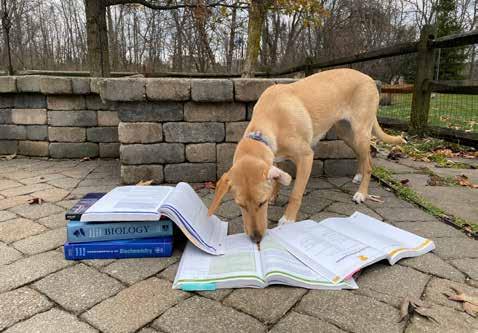
8 minute read
student spotlight So You Want to Be a Medical Student
by Sarah Robinson
So You Want to Be a Medical Student
The ins and outs of what it takes to apply to med school
Everybody knows that medical school is no joke, but the application process itself is almost as strenuous as the four-plus years of study.
“I’ve wanted to be a doctor since I was a little girl, but even I was a little daunted by the MCAT and the application process,” says Calsey Graham, 2016 graduate of Dublin Jerome High School and current med school applicant. “It’s not for the faint of heart.”
If you’ve got an aspiring anesthesiologist, a potential pediatrician or soon-to-be surgeon at home, or if you’re just curious about the process, Dublin Life Magazine has you covered with the top tips, tricks and insider knowledge for the medical school application process.
Pre-med preparation
Before starting on medical school applications, typically during a student’s junior and senior years of undergraduate study, there are some important boxes to check. The biggest piece of advice all college freshmen receive is, “Get involved!” Nothing is truer for med school applicants.
“Any student that’s thinking about pursuing medicine in the future should plan out their four years of college in advance,” says Graham. “Since there are so many different categories of involvement medical schools are looking for, like volunteering in both clinical and non-clinical settings, research, shadowing, leadership, etc., you have to make sure you can fit it all in.”
Assistant Director of Admissions & Outreach for the Ohio University Heritage College of Osteopathic MedicineDublin (OU-HCOM) Terry Porter says in addition to academic metrics and the MCAT, there are many other aspects of a student’s application that can stand out.
“We also strongly consider each candidate’s extracurricular activities, health care experiences, community volunteering hours, research exposure, leadership opportunities and why they want to practice medicine,” Porter says. “We look at all facets of the candidate through a holistic evaluation.”
It’s important for med school hopefuls to seek opportunities where they can develop skills relevant to their future, but also to get involved in things they genuinely enjoy.
“My biggest advice is to not worry about trying to be the ideal pre-med student, but to find something that you’re truly passionate about,” says Graham. “For me, since dogs have been a huge part of my life, one of my involvements on campus was raising two service dogs with 4 Paws for Ability at Ohio State.”
Of course, one of the most important and well-known aspects of a medical school application is the formidable MCAT exam. Just like the SAT or ACT, when applying for your undergraduate education, each individual medical school has a range of scores they tend to accept.
Graham used a ton of resources to prepare for the MCAT. She studied more than 1,800 MCAT practice questions and read more than 325 MCAT practice passages.

www.in nityliving.org Let us customize a quick & hassle- ee sale, making the most of your home’s equity to meet your timeline!
7 YEAR WINNER
Carolyn Redinger Broker / Owner/Realtor 614.679.1274 credinger@in nityliving.org
James Redinger Realtor / O ce Manager 614.679.2274
jredinger@in nityliving.org

Facebook.com/In nityLiving.org @in nitylivinghome
“Plan, plan and plan,” Porter says. “Students who most successfully completed the MCAT will probably tell you they gave themselves several months to create and follow a plan of study.”
He also explains that there are many study resources available and recommends candidates try all of them to find the right means of studying to match their style of learning.
“Talk to students who have completed the MCAT to see what they did to be successful and practice self-care throughout the experience,” he says. “It’s important to build in time to de-stress and re-energize.”
Unlike some standardized tests that students take in high school like the ACT and the SAT, the MCAT is definitely not a test to take blindly the first time to get a benchmark. Not only is the test more than eight hours long, it can cost upward of $300 each time.
“Usually, you want to study around four to six months for the MCAT, too,” adds Graham. “It’s divided into four sections, but it tests you on biochemistry, organic and inorganic chemistry, biology, physics, psychology, sociology and reading, so there’s a lot of material to cover.”
After carefully mapping out a four-year undergraduate plan and systematically

Graham trained two dogs for 4 Paws for Ability, Frasier and Murrell. Here she is with Murrell before his doggy graduation.
To MD or not to MD?
Your future physician has their choice of two similar and medical board-certified degrees – DO, or doctor of osteopathic medicine, and MD, or doctor of medicine. Whether you’re a DO or MD depends on the medical school you attend, but either degree can set you on a path toward whichever specialization you’d like.
So, what’s the difference?
The difference is rooted in educational philosophy. Think of an MD as a more traditionally western approach, whereas a DO’s education may focus more closely on holistic and preventative care. According to the American Medical Association, DOs work for around 200 additional hours of hands-on training with the musculoskeletal system.
Porter says that while it’s a good idea to have direction when first coming into school, it’s not necessary to know exactly which you field you want to go into.
“A student may have a strong idea of the area of medicine they want to practice when applying,” he says, “but that can easily change during their journey through medical school.”
Both MDs and DOs are licensed practitioners of medicine, can practice medicine and prescribe medication in all 50 states and may follow any route of specialization from general practice to surgery.
Medical school hopefuls can shadow both MDs and DOs to get an inside look at each type of physician and figure out which route is best for them.



GET TO KNOW THE UNMATCHED SERVICE & QUALITY OF DAVE FOX DESIGN | BUILD REMODELERS WWW.DAVEFOX.COM . (614)459-7211
studying for the MCAT on top of a rigorous course of study, it’s finally time to dive into the application process itself.
Application 101
The medical school application process is unlike an undergraduate college application. For starters, the average medical school applicant in 2020 applied to 17 schools, according to the Association of American Medical Colleges.
“I applied to 25 med schools, which is a lot, but I wanted to make sure I got in somewhere,” Graham says, laughing. “My criteria when looking at schools was distance from home and average MCAT scores. I applied to a range of schools, where I would be in the lower tier, middle tier and upper tier of applicant.”
After selecting the schools to apply to, it’s time for the swath of supplemental essays and personal statements. Each school has at least one but often times more than three essays required. If you do the math, that’s anywhere from 16 to 48 essays for the average medical school applicant.
“I wrote more than 100 essays. Some of them were only one or two paragraphs long, but some had to be longer. One school actually required nine supplemental essays,” says Graham. “Practically every school had a prompt about COVID this year. Many schools had essays about diversity, resilience, specific reasons you’re interested in that school and whatever else they want to know about you.”
“The applications that stand out to me are from candidates who have aligned with a service philosophy,” Porter says. “Also, I am always amazed by the many examples of perseverance I see from our candidates, from overcoming challenging life situations to being engaged in so many great experiences all while completing the rigorous courses needed to prepare for medical school.”
Finally, once essays are written and turned in, the waiting game begins. First, applicants need to make it to the interview stage before they can receive an acceptance, and each school functions on a different timeline.
“I turned in all of my application materials in August, had my first interview in November and got my first acceptance in December,” says Graham, “but I still have a few more interviews scheduled for after winter break, so my journey is not over yet!”
All schools may be looking for different things in an applicant’s interview, but Porter speaks for OU-HCOM.
“We are looking to see if the candidate is authentic,” he says. “We are looking to see if there a good fit between our college and the student and are looking to see if the candidate represents the values we have here.”
He notes that by the time an applicant reaches the interview stage, the admissions team is fairly confident that he or she is able to be academically successful, thus it’s really about the qualities needed to be a good fit.
Once an interview takes place, a medical school applicant’s chances of acceptance soar. But if they don’t get a call in the winter, there’s still hope.
Due to the high volume of applicants at each school, there are very active waitlists, so as soon as those with acceptances accept or deny their offer, those waitlisted get another shot. Students are sometimes even admitted into a program mere days before the term begins.
The best feeling of all, though, is getting an acceptance letter.
“It’s very surreal,” says Graham. “All my hard work and dedication has finally paid off.”
Sarah Robinson is a contributing editor. Feedback welcome at feedback@cityscenemediagroup.com.
Sonia Abuzakhm, M.D.
Andrew Grainger, M.D.
Joseph Hofmeister, M.D.
Elizabeth Kander, M.D.
Peter Kourlas, M.D.
Kavya Krishna, M.D.
Scott Blair, M.D. Jarred Burkart, M.D. Shabana Dewani, M.D.
Setting a new standard in CANCER CARE

810 Jasonway Ave. Columbus, Ohio 43214 Tel: (614) 442-3130 www.coainc.net
ALL PHYSICIANS ARE BOARD CERTIFIED
Christopher George, M.D.
Nse Ntukidem, M.D.
Emily Saul, D.O.
Thomas Sweeney, M.D.
Patricia Bordner, CNP
Jennifer Seiler, CNP










